PSYC 315: Midterm 1
1/128
There's no tags or description
Looks like no tags are added yet.
Name | Mastery | Learn | Test | Matching | Spaced | Call with Kai |
|---|
No study sessions yet.
129 Terms
what can we study in developmental psychology?
Describing what development looks like – what humans do, think, feel at different ages
Explaining what factors contribute to development – mechanisms allowing people to figure out new things, biological or environmental components
Applying findings for programs, policies, advice that can improve lives of children and youth
developmental stages
1. Prenatal: conception to birth
2. Infancy: birth – 3 years
3. Early Childhood: 3 – 6 years
4. Middle Childhood: 6 – 11 years – start of formal schooling is a shift
5. Adolescence: 11 – 18/19 – start of puberty (the shift)
6. Early/Emerging Adulthood: newer phase – 19/20 – 25
7. Adulthood: 25+
advantages of developmental theories
provide a framework for understanding important phenomena
raise crucial questions about human nature
lead to better understanding on children
domains of development
physical, social and emotional, cognitive
all are related and overlap - puberty affects all
human nature
is who you are determined by experiences (tabula rasa) or do all enter the world with inherent abilities?
nature
biological endowment; genes
nurture
physical and social environment - environment differences begin at conception
nature vs nurture
interplay with each other - not just one or the other
developmental change
continuous (gradual development) vs discontinuous (stages)
Mechanisms of change: biological processes, experiences, timing of experiences
role of context
development depends on a number of external factors - family, peers, school, community, socioeconomic status, culture, time period
self/other report
surveys (often filled out by parents), interviews, standardized tests
advantages: can probe inner experience, easy to administer
Naturalistic observation
observing behaviour in its natural setting
time-sampling or event-sampling
challenges: so much behaviour at once
advantages: reflects real-world behaviour, can be affordable
time-sampling
record all behaviours during pre-determined time periods
event-sampling
record behaviour every time event of interest occurs
structured observation
researcher sets up situation to evoke behaviour of interest - control environment
advantages: useful for rare behaviour, more control
physiological measures
heart rate, blood pressure, hormone levels, pupil dilation
neuroimaging: MRI, fMRI, NIRS
advantages: access biological underpinnings, doesn’t require language
EEG/ERP
measures electrical activity in brain while brain is working
MRI
measures brain structure using magnetic fieelds
fMRI
measures blood flow using magnetic fields
NIRS
measures blood flow in brain using light
reliability
consistency/repeatability of measures
validity
measures what researcher thinks its measuring
internal validity
conditions internal to design of study allow for accurate measurement
external validity
findings generalize beyond original assessment
correlational designs
examine relationships between variables with no experimental manipulation
does not equal causation
experimental designs
researcher manipulates IV and measures change in DV(s)
participants randomly assigned to different groups
able to examine cause-effect
longitudinal designs
same participants measured repeatedly across time at different ages
cross-sectional designs
different groups of participants at different ages measured at same time
sequential designs
combining longitudinal and cross-sectional methods - follow multiple samples of different ages over time
micro-genetic designs
track development over a short period of time over closely-spaced sessions 0 for training effects or skill learning
challenges in researching development
difficult population to study (ethics, cooperation, participant recruitment)
difficult to study changes with age (measurement equivalence for each age group, understanding what causes change)
scientific method
systematic testing of logical hypotheses
strengths: scientific community builds on each other, constantly changing/updating, publicly shared knowledge
limitations: can’t answer all questions, embedded within context, biased
positionality
our positions in society - contexts, identities, access - affecting how we see the world
causes biases in knowledge processing
cognitive development
how we learn, think, problem solve, use language
jean piaget (1896-1980)
founder of of development psychology theory - stage theory
constructivist: children construct their own understanding of the world (child as scientist)
children are motivated to learn - don’t need reward
our understanding is organized by schemas and we change through assimilation and accommodation
discontinuous development - 4 stages
assimilation
new information viewed through existing schemas and added to them - Piaget
accomodation
schemas are adapted to new experiences - Piaget
equilibration
people balance assimilation and accommodation to create stable understanding
become unsatisfied with current knowledge and feel the need to balance shortcomings
central properties of Piaget’s stage theory
qualitative change through stages
broad applicability across topics/contexts
brief transitions between stages
universal order and progression
sensorimotor stage (0-2 years)
accomplishments: begin to learn about the world through touching, sucking, looking, reaching - motor skills; learn through environment adaptation and modify reflexes
develop object permanence round age 1 (fragile - A-not-B error)
form deferred imitation at 18-24 months
gaps: lack mental representation of the world, not able to think about moving through the world
object permanence
knowledge objects continue to exist event out of view
A-not-B error
tendency to reach for a hidden object where it was last found rather than new location it was last hidden
deferred imitation
repetition of other people’s behaviour substantial time after it actually occured
pre-operational stage (2-7 years)
accomplishments: symbolic representations (pretend play), big gains in language
gaps: not capable of understanding logical rule, struggle with conservation (centration), egocentric
3 Mountain Task
symbolic representations
able to understand that something can stand for something else (pretend play)
conservation
understanding physical propertieis do not change despite changes in form/appearance (pouring a glass of water into a different sized glass)
centration
focus on one aspect of a thing, not the overall picture
egocentrisim
inability to take other people’s perspectives
3 Mountain Task
also seen in conversation - talk over each other, can’t stay on one topic
3 Mountain Task
can’t figure out what is closest to the doll - will just say what is closest to them
concrete operational stage (7-12 years)
accomplishments: able to use mental logic to reason about concrete things, understand conservation, no longer egocentric
gaps: reasoning about abstract, hypothetical concepts - can’t think systematically
pendulum task
formal operational stage (12+ years)
accomplishments: able to use mental logic to reason about abstract, hypothetical things, logically test hypotheses (Pendulum Problem)
not universal - not everyone can conjure abstract ideas
pendulum problem
what contribute to how much a pendulum swings? children will test random things instead of making logical conclusions (able to once they are 12)
piaget’s legacy
foundation of cognitive development and future theories, idea of natural limits at a given age, children contribute to their development
criticisms: overemphasized clear-cut stages, underestimate sociocultural influences, defining tests of cognition too hard, vague about mechanisms behind development, child’s thinking is not as consistent
Lev Vygotsky’s Theory of Cognitive Development
gradual, continual shifts in knowledge during development - children as social learners
continuous theory
zone of proximal development
scaffolding
language as the most important tool for cognitive development - allows learners to think about the world (private speech)
children as teachers and learners
Vygotsky’s phases of development
children’s behaviour controlled by other people’s statements → children’s behaviour controlled by own private speech spoken out loud → behaviour controlled by internalized private speech
zone of proximal development
able to do things only with the help of others
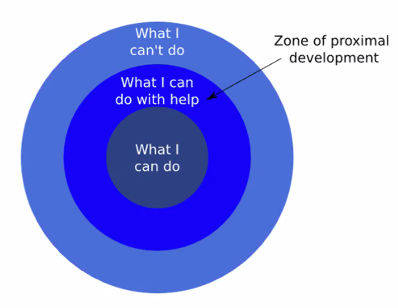
scaffolding
teachers adjust level of support they offer to fit learner’s needs
giving help but no more than needed
intersubjectivity
mutual understanding that people share during communication - foundation of sociocultural development
focus on same topic, each other’s reactions
joint attention in infants
Vygotsky’s Legacy
Praise: emphasis on culture, role of teaching, impact
Criticisms: overemphasis on language, undervalues biology
Vygotsky vs. Piaget Similarities
focus on child
children as active learners
Vygotsky vs. Piaget contrasts
learning through self-discover (P) vs. through social collaboration (V)
discontinuous change (P) vs. continuous change (V)
universal processes of development (P) vs. development as culturally situated (V)
language and thought as largely unrelated (P) vs. language as key to learning (V)
theory of mind
ability to think about mental states in ourselves and others - understanding mental states influence behaviour
comes back to egocentrism
main components of theory of mind
understanding representational states are
understanding certain state might misrepresent a situation
appreciating that the same situation might be represented differently by two agents
false belief: Sally Anne Task
Sally leaves her marble in her basket then leaves → Anne takes the marble out of the basket and puts it in her box → Sally comes back → where will Sally look for the marble?
Sally has a false belief her marble is in her basket
false belief: smarties box
Child is asked what is in the Smarties box → Child answers Smarties → the box is opened and there are pencils in the box → the box is closed and the child is asked what would their friend expect to be in the box without opening it?
Child has a false belief Smarties are in the box
false belief tasks (theory of mind)
children under 4 fail them (Sally-Anne, Smarties Box)
evidence suggests that these tasks are too hard and infants can even succeed at them with easier methods
similar across cultures
theory theory for theory of mind
change in thinking from desire guided behaviour to belief guided behaviour
simulation theory for theory of mind
use imagination, role taking to put yourself in new perspectives
either introspection, or simple imagination
modular theory for theory of mind
brain maturation of parts of brain related to thinking
nativism
fundamental theory of mind capacities are realized by module that explains other people’s behaviour by mental state ascription - basically innate
two-systems account
theory of mind is to some degree innate but the initial capacities are subserved by a simpler system that is automatic and inflexible
influences on theory of mind
number of siblings (specifically older siblings)
pretend play
parenting (parents who label things with emotions0
language (bilingualism leads to earlier theory of mind)
autism
development of theory of mind
1 year: children follow the gaze of other people, show sensitivity to intentional structure of action
will reproduce the correct action another person is failing to do, will copy bizzare means to an end
12-18 months: understand that another person might not see the object they are seeing
keeps developing into middle adulthood and adolescence
remains relatively constant over lifespan
autism and theory of mind
show delays in development
also show social-cognitive deficits in infancy
what drives theory of mind?
language (specifically language that encourages independent thought)
executive functions (inhibition, working memory - enable flexible coordination, embedding, suppression of perspectives)
family (maternal education, SES)
network of cortical regions
social cognition
understanding and thinking about mental states, how mental states guide behaviour; understanding and thinking about social groups
infants understanding of race
infants prefer familiar race faces, respond to race as a perceptual category
understanding of race at 3-4 years
explicitly characterize race, reason about skin colour as stable
eventually see race as an informative feature of identity
explicit attitudes
attitudes a person consciously endorses and can report
aware of biases, can access them, easily controlled

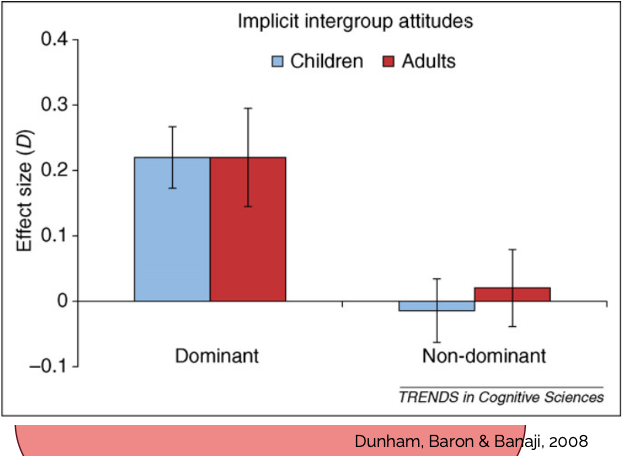
intergroup bias
intuitive to group people together by perceived group indicators - develop biases/preferences to specific groups (more dominant/powerful)
in-group positivity and out-group negativity
declines with development
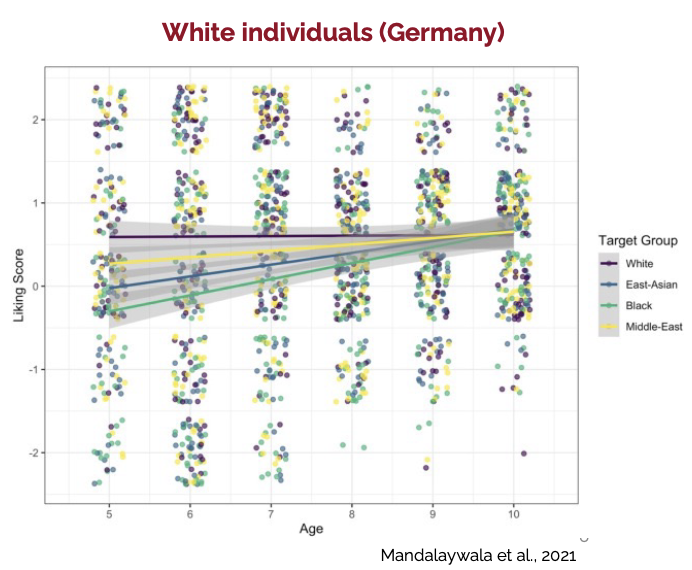
clark’s doll study (1947)
does racial segregation impact how black children felt about their own group? – this study showed that black children associated white dolls with positive terms (nice, pretty) and black dolls with negative terms (bad, ugly)
in-group positivity increases with age
implicit biases
beliefs, attitudes activated in response to social cues
have less awareness
more difficult to control
implicit association tese
measures strength of association between concept and attribute
response time (faster = stronger association)
implicit attitudes of racial groups
dominant groups have a pro in-group preference and non-dominant groups do not have a preference
remain consistent across lifespan
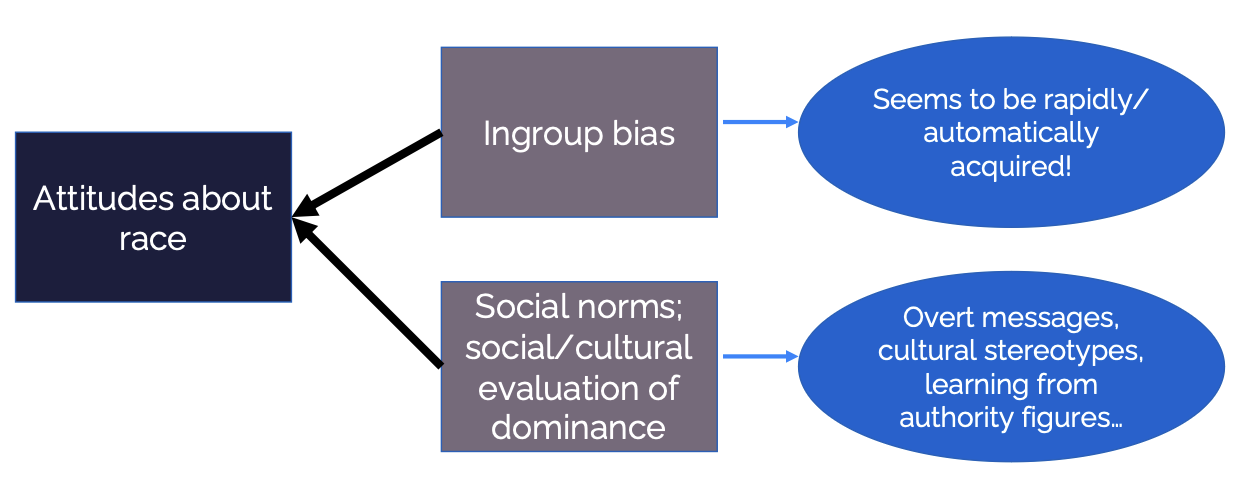
development of intergroup bias
biological and evolutionary reasons
EX. Latinx adults and children don’t prefer white people over Latinx, but they do prefer Latinx people over black people
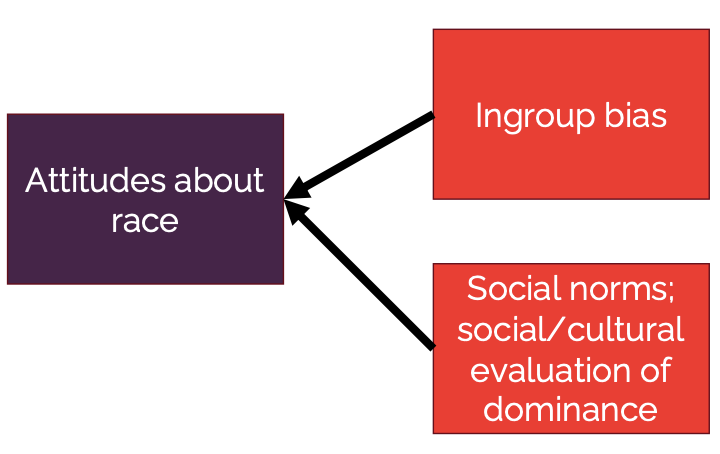
minimal group paradigm
method for investigating the minimal conditions required for discrimination to occur between groups - rapidly acquires
Bring kids in red shirts and kids in blue shirts in to play with each other – kids had a higher preference for kids wearing the same shirt as them
IAT issues
side/order effects
reliability (impact of context)
meaningful (are predictions generalizable to large group)
what works in adults to reduce intergroup bias?
Personal contact with out-group members
Encountering positive examples of out-group members
But, effects aren’t strong - children more malleable
reducing implicit bias in children (Gonzalez, Steele, & Baron (2017))
White and Asian children aged 5-12 exposed to examples of either white or black individuals in a positive or negative light or flowers (control) – child IAT
Results: younger children ~7 years showed a pro-white bias, older children (~10 years) did not show a pro-white bias when shown pictures of positive black associations

language
system of symbols used to communicate - meaningless elements made into structures with meaning
language form
phonemes, morphemes, syntax
language content
semantics - the meaning
language use
pragmatics - rules of conversation
phonemes
sounds of language
morphemes
smallest units of distinguishing meaning in language
syntax
rules for how to combine phonemes and morphemes
language acquisition
nature: humans have an advanced syntax compared to other animals
nurture: need exposure to language to learn it - timing is important
critical period of language learning
2 years to puberty
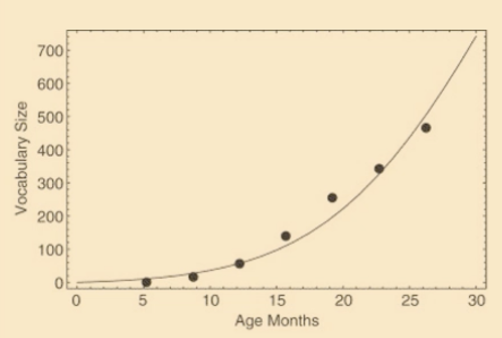
language competence
ability to understand components of language
10-12 months: discriminated and produce sounds of their languages - first words ~12 months
18 months: combining words
2 years: vocab of 200-500 words
3 years: longer, more complex sentences
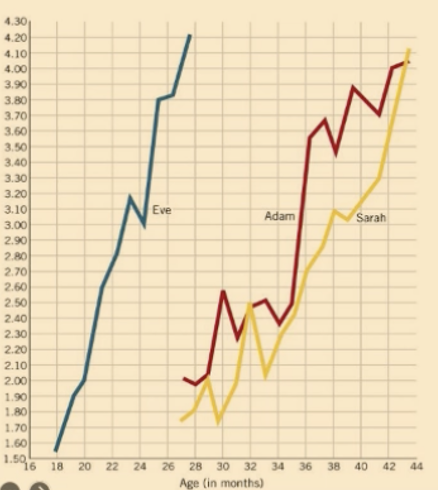
talking to yourself (Piaget)
egocentric speech - children not orienting their speech to anyone
collective monologues: two individuals speaking to each other but not for the purpose of each other